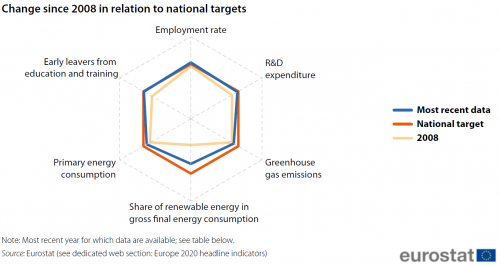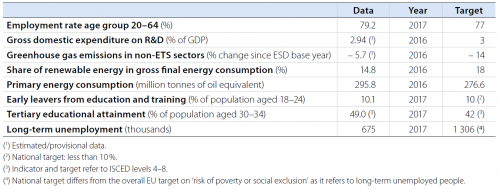Archive:Europe 2020 indicators - Germany
Data extracted in June 2018.
Planned article update: September 2019.

Source: Eurostat (see dedicated web section: Europe 2020 headline indicators) and DESTATIS
Explanations on this radar chart are available here.
This article is part of a set of statistical articles on Europe 2020 strategy, focusing on the situation in Germany.
Full article
Long-term unemployment, used in Germany as a national target in the area of poverty and social exclusion, went down by 58.5 % between 2008 and 2017. This allowed the country to significantly exceed its target of reducing long-term unemployment by 20 % by 2020. Germany had already met its 77 % employment target in 2013 and continued to increase its employment rate until 2017. In 2017, Germany also surpassed its national target on tertiary educational attainment by 7.0 percentage points, with 49.0 % of 30 to 34 year olds having completed post-secondary level education or equivalent. Germany’s national target differs from that of other Member States because it includes post-secondary non-tertiary education (ISCED level 4) in addition to ISCED levels 5 to 8. In addition, Germany was only 0.1 percentage points away from meeting its target for early leavers from education and training in 2017. In 2016, the country almost reached its national targets for R&D expenditure. Between 2008 and 2016, Germany reduced the distance to its national targets on primary energy consumption and renewable energy by more than half. However, a gap of 8.3 percentage points to its target on GHG emissions in non-ETS sectors persisted in 2016.

Source: Eurostat (see dedicated web section: Europe 2020 headline indicators and (lfsa_ugad)) and DESTATIS
Data sources
More information about the origin of the data and the calculation of indicators can be obtained via the Europe 2020 indicators dedicated website.
Under 'Main tables', click on the icons next to the indicators:
- 'Explanatory texts (metadata)' for a detailed overview of the collection and compilation methods;
- 'Information on the leaf' for data availability per country.
A more general overview of quality procedures can be found in Implementation of standard reference metadata for indicators - the ESMS Indicator Profile (ESMS-IP) (PDF file).
Context
Europe 2020 is the EU’s agenda for jobs and growth for the current decade. It emphasises smart, sustainable and inclusive growth as a way to strengthen the EU economy and prepare its structure for the challenges of the next decade. As a main objective, the strategy strives to deliver high levels of employment, productivity and social cohesion in the Member States, while reducing the impact on the natural environment.
Direct access to
- Smarter, greener, more inclusive - indicators to support the Europe 2020 strategy - 2018 edition (online publication, also downloadable as PDF file
- Towards robust quality management for European Statistics - Communication from the Commission to the European Parliament and the Council COM(2011) 211 final.
- Regulation (EC) No 223/2009 of 11 March 2009 on European statistics